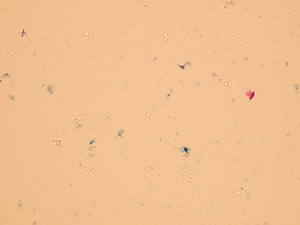Faculty of Medicine, Masaryk University
RNDr. Miroslava Beňovská, Ph.D., Mgr. Ondřej Wiewiorka, MUDr. Jana Tůmová
Microorganisms
Bacteria
Bacteria are single celled organisms. They have shapes of spheres (cocci) or rods and usually reach size of a few micrometers.
Small amount of bacteria in urine is quite common finding. Urine should be analyzed within one hour, otherwise the bacteria multiply. They tend to form chains or occur as longer fibers. Antibiotic treatment may cause bacteria cell wall disintegration producing unusually long rod-shaped elements called bacteria protoplasts. Larger quantities of bacteria can often be found in pathological urine with leukocytes.
Stained sediment
Native sediment
Pictures from iQ 200 analyzer (IRIS)
Yeasts
Yeasts are quite common pathological finding. They are unicellular microorganisms with typical round or oval shape. They multiply by budding and in some cases they form pseudomycelium (fibrous form of yeast). They may occur in urine of immunodeficient or immunosuppressed patients and may also be present in urine of diabetics, because glucose contributes to their growth. The most common species in urine is Candida albicans.
Stained sediment
Native sediment
Pictures from iQ 200 analyzer (IRIS)
Mgr. Ondřej Wiewiorka , MUDr. Jana Tůmová|
KLT, Faculty of Medicine, Masaryk University |
Back to Homepage, accessibility |
| Service Center for E-learning
| Faculty of Informatics, Masaryk University, 2015
Centrum interaktivních a multimediálních studijních opor pro inovaci výuky a efektivní učení | CZ.1.07/2.2.00/28.0041














